

2017 FEB 28
(DEC 29) NASA's NEOWISE mission has recently discovered some celestial objects traveling through our neighborhood, including one on the blurry line between asteroid and comet. More

Just hours after the winter solstice, a mass of energetic particles from the Sun smashed into Earth's magnetic field, stirring up a display of northern lights over Canada. An instrument on NASA's Suomi NPP satellite acquired this view of the aurora from orbit on December 22. Suomi NPP was launched from Vandenberg AFB, Calif. in 2011. Image courtesy of NASA
(DEC 19) The U.S. Navy will provide Lockheed Martin Space Systems Co., Sunnyvale, California, $88,097,058 for modifications to a previously awarded contract for Trident II (D5) submarine-launched ballistic missile field processing and deployed system support.
The work will be performed in several locations including Chandler, Arizona; Campbell, Palo Alto, Santa Ana, Santa Clara, Santa Fe Springs, Santa Rosa, Sunnyvale, and Torrance, California; Denver, Colorado; and Magna, Utah.
The work should be completed by September 2021.
Department of Defense
(DEC 12) TUCSON, Ariz. - The University of Arizona-led OSIRIS-REx mission will take advantage of its two-year outbound cruise to the asteroid Bennu in order to conduct a search for elusive solar system objects. Between Feb. 9 and 20, the NASA spacecraft will activate its onboard camera suite and commence a search for Earth-Trojan asteroids. More
(DEC 2) COLORADO SPRINGS, Colorado, Dec. 1, 2016 - Lockheed Martin (NYSE: LMT) has completed a major upgrade to modernize the current ground control system of the U.S. Air Force's Global Positioning System (GPS) satellite constellation.
The Commercial Off-the-Shelf (COTS) Upgrade #2 (CUP2) project is the latest step in the Air Force's multi-year plan to refresh technology and transform the legacy Operational Control Segment - known as the Architecture Evolution Plan (AEP) -- into a modern, high-performance command and control system. On October 15, CUP2 became fully operational and began managing the 31 GPS IIR, IIR-M and IIF satellites that make up today's GPS constellation.
The Air Force awarded Lockheed Martin the CUP2 project in November 2013 under its GPS Control Segment (GCS) contract, and the system is now fully deployed into the AEP's GPS Master Control Station and the Alternate Master Control Station. This is the third major technology refresh of the GPS command and control system since the GCS contract began in January 2013.
This upgrade to the existing ground control system provides the Air Force with flexibility. In May, as part of Contingency Operations (COps) under the GPS III contract, Lockheed Martin demonstrated a preliminary design to build off CUP2 and further upgrade the AEP to support next generation GPS III satellites as they perform their positioning, navigation and timing mission. COps is a temporary gap filler prior to the entire GPS constellation's transition onto the next-generation Operational Control System (OCX) Block 1, which is currently in development.
The Global Positioning Systems Directorate at the U.S. Air Force Space and Missile Systems Center contracted the CUP2 upgrade. Air Force Space Command's 2nd Space Operations Squadron (2SOPS), based at Schriever Air Force Base, Colorado, manages and operates the GPS constellation for both civil and military users.
Lockheed Martin
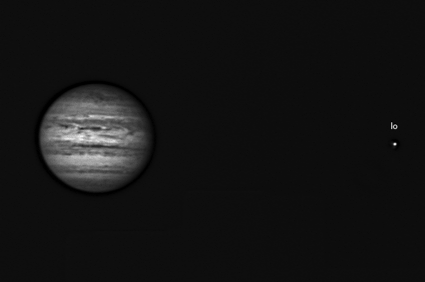
Jupiter, the largest planet in our solar system, is currently visible in the east before sunrise. Tom Ashcraft recorded this view of the giant planet and its moon Io in infrared light on the morning of November 23 from Lamy, New Mexico. Image copyright 2016, Thomas Ashcraft. Used with permission
(NOV 26) NASA has selected Space Exploration Technologies (SpaceX) of Hawthorne, California, to provide launch services for the agency's Surface Water and Ocean Topography (SWOT) mission. Launch is targeted for April 2021 on a SpaceX Falcon 9 rocket from Space Launch Complex 4E at Vandenberg Air Force Base in California.
The total cost for NASA to launch SWOT is approximately $112 million, which includes the launch service; spacecraft processing; payload integration; and tracking, data and telemetry support.
Designed to make the first-ever global survey of Earth's surface water, in addition to high-resolution ocean measurements, the SWOT mission will collect detailed measurements of how water bodies on Earth change over time. The satellite will survey at least 90 percent of the globe, studying Earth's lakes, rivers, reservoirs and oceans, at least twice every 21 days, aid in freshwater management around the world, to improve ocean circulation models and weather and climate predictions. The SWOT spacecraft will be jointly developed and managed by NASA and the French space agency Centre National d'Etudes Spatiales (CNES).
NASA's Launch Services Program at Kennedy Space Center in Florida will manage the SpaceX launch service. The SWOT Project office at NASA's Jet Propulsion Laboratory in Pasadena, California, manages spacecraft development for the agency's Science Mission Directorate in Washington.
NASA
(NOV 16) TUCSON, Ariz. - Sputnik Planitia, a 1,000-kilometer-wide basin within the iconic heart-shaped region observed on Pluto's surface, could be in its present location because accumulation of ice made the dwarf planet roll over, creating cracks and tensions in the crust that point toward the presence of a subsurface ocean. More
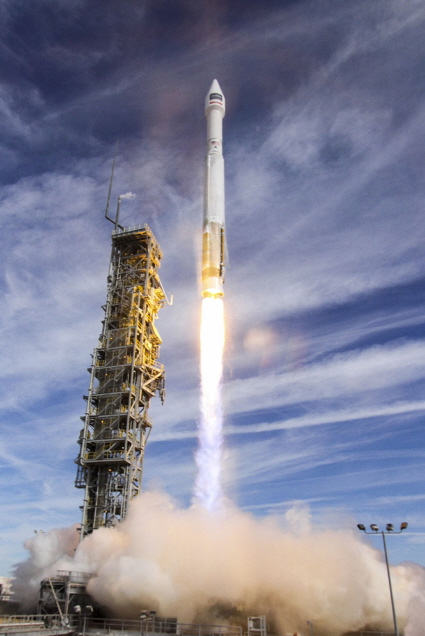
An Atlas V rocket carrying the WorldView-4 earth imaging satellite lifts off from Vandenberg AFB on November 11. Image credit: United Launch Alliance
(NOV 11) VANDENBERG AIR FORCE BASE, Calif. - Team Vandenberg successfully launched a commercial satellite on a United Launch Alliance Atlas V rocket provided by Lockheed Martin Commercial Launch Services from Space Launch Complex-3 here Friday, Nov. 11, at 10:30 a.m. PST.
Col. Chris Moss, 30th Space Wing commander, was the launch decision authority.
The 30th Space Wing at Vandenberg Air Force Base is responsible for safety and launch operations from the Western Range.
The Atlas V rocket carried the DigitalGlobe WorldView-4 satellite built by Lockheed Martin.
The satellite will more than double DigitalGlobe's coverage of the world's highest-resolution commercial imagery and increase the rate at which it grows its 15-year library of time-lapse high-resolution imagery. WorldView-4 will orbit Earth every 90 minutes, traveling 17,000 miles per hour and capturing more than 680,000 square kilometers of the Earth's surface daily (18 terabytes) - the equivalent of the land area of Texas.
Vandenberg AFB
(NOV 1) Scientists have produced the first global maps of human emissions of carbon dioxide ever made solely from satellite observations of the greenhouse gas. More
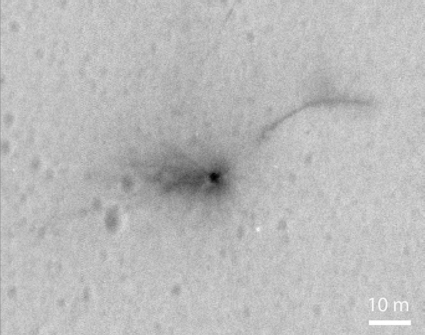
A small crater marks the demise of the European Space Agency's ill-fated Schiaparelli Mars lander. The ESA attempted to soft land Schiaparelli on the Red Planet on October 19. Several days later, NASA's Mars Reconnaissance Orbiter recorded this image of Schiaparelli's impact crater. The Jet Propulsion Laboratory, a division of Caltech in Pasadena, California, manages the Mars Reconnaissance Orbiter Project for NASA. Image credit: NASA/JPL-Caltech/Univ. of Arizona
(OCT 25) NASA has awarded a delivery order under the Rapid Spacecraft Acquisition III (Rapid III) contract to Orbital Sciences Corporation of Dulles, Virginia, known publicly as Orbital ATK, for the Landsat 9 spacecraft.
This contract is a 5-year, firm fixed-price delivery order for the purchase of the Landsat 9 spacecraft in the amount of $129.9 million. Orbital will design and fabricate the spacecraft, integrate the mission's two government-furnished instruments, and conduct satellite-level testing, in-orbit satellite checkout, and mission operations support. The work will be performed at the contractor's facilities and at the launch site at Vandenberg Air Force Base in California.
The spacecraft will extend the Landsat program's record of land images to half a century. Landsat has provided accurate, 98-foot (30-meter) resolution, multi-spectral, global measurements of Earth's land cover since 1972, building a freely available archive of more than six million satellite images. With data from Landsat satellites, ecologists have tracked deforestation in South America, water managers have monitored irrigation of farmland in the American West, and researchers have watched the growth of cities worldwide.
NASA
(OCT 22) WASHINGTON - The most sophisticated space surveillance telescope ever developed is ready to begin tracking thousands of space objects as small as a softball. More
The internal structure of Hurricane Nicole is visible in this cross section produced from data collected by NASA's CloudSat spacecraft during a pass over hurricane on the morning of October 12. The image (click to enlarge) shows the curved outward appearance from the surface to cloud top height of the eyewall, cirrus bands extending outwards, and heavy precipitation in the rain bands surrounding the eyewall. CloudSat was launched from California's Vandenberg AFB in 2006. Image courtesy of NASA and Colorado State University
(OCT 14) On Tuesday evening, October 18, observers in California and surrounding areas can see the Moon pass in front (occult) of the bright star Aldebaran. Sky watchers within a narrow path will be treated to an interesting display known as a grazing occultation. Occultation expert David Dunham elaborates:
"From 10:25-10:29 pm PDT, Aldebaran will fade in and out, or only partially reappear as a brief flash, as mountains and craters along the northern edge of the 85% waning Moon repeatedly covers and uncoveres all or part of the orange giant's disk, in a narrow path passing from Marina Del Rey, then over downtown Los Angeles, parts of Alhambra and Monrovia, the San Gabriel Reservoir (Hwy 39), and then over the Mojave Desert, s.e. of Wrightwood and over parts of Hesperia and Apple Valley. The graze will occur against the narrow dark-side "crescent" 12 degrees from the ill-defined northern cusp. The Moon will be 19 degrees above the eastern horizon. Many maps and other details about the graze are at www.occultations.org/Aldebaran/2016October."
Brian Webb
(SEP 27) LOS ANGELES AIR FORCE BASE, El Segundo, Calif. -- The Space and Missile Systems Center signed a Cooperative Research and Development Agreement (CRADA) with United Launch Alliance (ULA) as part of the company's effort to certify its new Vulcan launch vehicle for National Security Space (NSS) missions.
This CRADA enables the Air Force to evaluate the Vulcan launch system according to the Air Force's New Entrant Certification Guide (NECG), and contains a detailed Certification Plan that specifies all of the non-recurring activities. As part of the evaluation, SMC and ULA will look at flight history, vehicle design, reliability, process maturity, safety systems, manufacturing and operations, systems engineering, risk management and launch facilities. SMC will monitor at least two certification flights to meet the flight history requirements outlined in the NECG.
While certification does not guarantee a contract award, it does enable a company to be awarded competitive launch services contracts.
In addition to the Vulcan CRADA, SMC anticipates entering into additional CRADAs with SpaceX for their Falcon Heavy rocket and with Orbital-ATK for their Next Generation Launcher.
Currently, ULA's Delta IV and Atlas V, and SpaceX's Falcon 9 Upgrade are the only certified launch vehicles for sending NSS payloads into orbit. Having multiple certified launch vehicle providers and multiple families of launch systems bolsters U.S. assured access to space.
Los Angeles AFB
(SEP 19) PALO ALTO, Calif. - Delivering the most detailed images of the sun's lower atmosphere ever recorded from space, the Interface Region Imaging Spectrograph (IRIS), built and operated by Lockheed Martin (NYSE: LMT) for NASA, has received more time to deliver groundbreaking space science. More
(SEP 7) TUCSON, Ariz. - In the mid-1800s, astronomers surveying the night sky in the Southern Hemisphere noticed something strange: Over the course of a few years, a previously inconspicuous star named Eta Carinae grew brighter and brighter, eventually outshining all other stars except Sirius, before fading again over the next decade, becoming too dim to be seen with the naked eye. More
(SEP 5) BARKSDALE AIR FORCE BASE, La. - A team of Air Force Global Strike Command Airmen from the 341st Missile Wing at Malmstrom Air Force Base, Montana, launched an unarmed Minuteman III intercontinental ballistic missile equipped with a test reentry vehicle Sept. 5 at 2:10 a.m. Pacific Daylight Time from Vandenberg Air Force Base, California. More
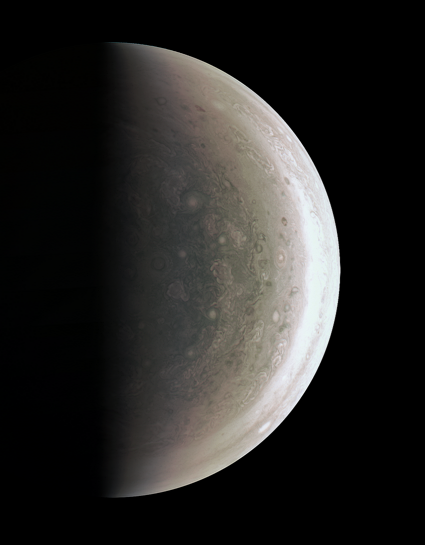
This image from NASA's Juno spacecraft provides a never-before-seen perspective on Jupiter's south pole. The JunoCam instrument acquired the view on 2016 August 27 when the spacecraft was about 58,700 miles (94,500 kilometers) above the polar region. At this point, the spacecraft was about an hour past its closest approach, and fine detail in the south polar region is clearly resolved. NASA's Jet Propulsion Laboratory, Pasadena, California, manages the Juno mission for the principal investigator, Scott Bolton, of Southwest Research Institute in San Antonio. Image courtesy NASA/JPL-Caltech/SwRI/MSSS
(SEP 3) VANDENBERG AIR FORCE BASE, Calif. -- The launch of an unarmed Minuteman III intercontinental ballistic missile has been delayed due to the forecasted hurricane weather over the Hawaiian Islands.
The missile was set to launch from Vandenberg Air Force Base Sunday, Sept. 4, with a launch window of 12:01 a.m. to 6:01 a.m. PDT. The launch has been rescheduled with a time frame of Monday, Sept. 5, between 12:01 a.m. to 6:01 a.m.
Vandenberg AFB
(AUG 24) LOGAN, UTAH - The Utah State University Research Foundation and its Space Dynamics Laboratory announced that it has received an indefinite delivery, indefinite quantity contract valued at up to $99.4 million over the next five years from the Department of Defense.
The contract award supports the Missile Defense Agency's mission to develop and field an integrated, layered, ballistic missile defense system to defend the United States, its deployed forces, allies, and friends against all ranges of enemy ballistic missiles in all phase of flight.
USU Research Foundation/Space Dynamics Laboratory
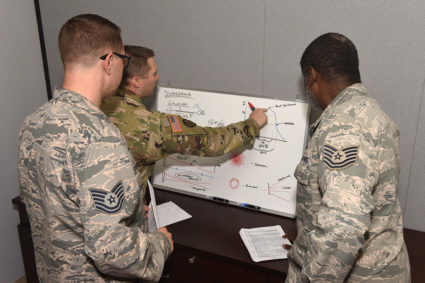
Army Capt. Austin Baker and Air Force Tech. Sgts. Joshua Tarrant and Jeffrey Orr of Vandenberg AFB's Joint Space Operations Center Laser Clearinghouse conduct training on laser divergence. Laser divergence helps determine how much energy a satellite may inadvertently receive when a ground-based laser is pointed skyward. The clearinghouse ensures that Defense Department laser activities are conducted in a safe and responsible manner that protects space systems, their mission effectiveness, and humans in space. (U.S. Air Force photo by Airman 1st Class Robert J. Volio)
(AUG 18) ALBUQUERQUE, N.M. - Sandia National Laboratories' Jaime Gomez was too busy to celebrate the successful launch of the latest nuclear detonation detection system - he was already deep into the next generation. More
(AUG 9) A 3-D sky-mapping project that will measure the light of millions of galaxies has received formal approval More

The Sand fire near Los Angeles, Calif. destroyed 18 houses and caused one death. NASA's ASTER instrument aboard the Terra spacecraft acquired this image of the burn area on August 1. Vegetation is shown as red, the burn area as dark (irregular area in the middle). Credit: NASA/METI/AIST/Japan Space Systems, and U.S./Japan ASTER Science Team
(AUG 3) TUCSON, Ariz. -- The U.S. Missile Defense Agency exercised a $523 million contract option with Raytheon Company (NYSE: RTN) to produce, test and deliver 47 Standard Missile-3 (SM-3) Block IB interceptors for operational testing and deployment.
This is the fiscal year 2016 option under the $2,351,177,872 contract for Standard Missiles awarded to the company in 2015. The guided missiles are used by the U.S. Navy to provide regional defense against short-to-intermediate-range ballistic missile threats.
"Standard Missile-3 plays a critical role in the missile defense of the U.S. and its allies," said Dr. Taylor W. Lawrence, Raytheon Missile Systems president. "SM-3's sophisticated capability to destroy enemy ballistic missiles in space, and its flexibility to deploy from land or from sea make it invaluable as the centerpiece of the President's Phased Adaptive Approach for missile defense in Europe."
Production under this contract will be completed at Raytheon's world-class Space Factory in Tucson, Ariz., and integration will take place at Raytheon's state-of-the-art integration facility in Huntsville, Ala.
Raytheon
(JUL 28) Vandenberg Air Force Base - After a more than 250-mile road trip in a cleanroom-on-wheels, Lockheed Martin (NYSE: LMT) delivered DigitalGlobe's (NYSE: DGI) WorldView-4 satellite to Vandenberg Air Force Base. More
(JUL 18) An international team of astronomers led by the University of Arizona has discovered and confirmed a treasure trove of new worlds using NASA's Kepler spacecraft on its K2 mission. More
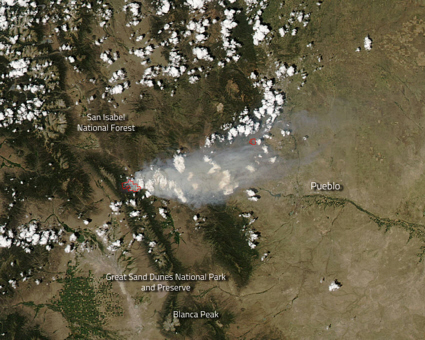
A lightning strike on July 8 sparked a fire in Colorado's Hayden Pass. The blaze later spread from the San Isabel National Forest to the Rio Grande National Forest and other areas. NASA's Aqua spacecraft recorded this image of the fire during a daylight pass on July 11. Image courtesy of Jeff Schmaltz LANCE/EOSDIS MODIS Rapid Response Team, GSFC
(JUL 15) Orbital ATK Inc., Chandler, Arizona, has been awarded an $182,067,817 fixed-price-incentive, fixed-price-plus-award-fee, cost-plus-award-fee, cost-plus-fixed-fee contract for the medium-range ballistic missile type 3 configuration 2 target system including production equipment, logistics, associated support equipment, system engineering and analysis, and mission operations. Work will be performed in Chandler, Arizona, and is expected to be completed by Oct. 30, 2020. The Missile Defense Agency, Huntsville, Alabama, is the contracting activity.
Department of Defense
(JUL 6) The Ventura County Astronomical Society will host its Annual Open House-Star Party on Saturday July 16 at Moorpark College observatory. The event will take place from 8 to 10 p.m. at 7075 Campus Road, Moorpark, Calif.
Ventura County Astronomical Society
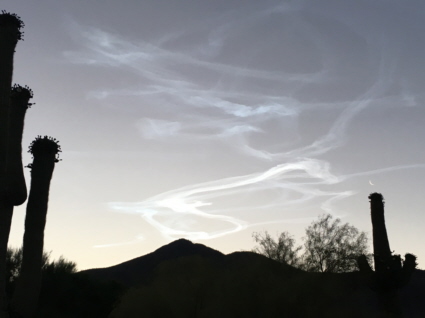
At 03:56 PDT on June 2, a brilliant meteor streaked across the Arizona sky. Arizona resident Paul Maley was on a 4-mile run when he noticed an interesting cloud in the dawn sky. A short time later he took this image which was later determined to be the meteor's twisted aftermath. Copyright © 2016, Paul Maley. Used with permission
(JUN 2) During the early hours of June 2nd, a 3-meter wide asteroid struck Earth's atmosphere over Arizona. The resulting explosion shook the ground and blinded cameras with a flash of light 10x brighter than the full Moon. Meteorite hunters are now scouring the landscape north of Tucson for fragments of the space rock.
Spaceweather.com
(MAY 24) BOULDER, Colorado - The National Solar Observatory launches its new headquarters in Boulder, Colorado, by hosting a national conference on cutting-edge solar astronomy.
The National Solar Observatory (NSO) has been at the forefront of ground-based solar astronomy for more than 60 years. The institution celebrates the relocation of its headquarters to Boulder, Colorado, from Tucson, Arizona, by hosting the American Astronomical Society's Solar Physics Division annual meeting. This event brings together hundreds of solar scientists from around the world. The Solar Physics Division meeting will run from Tuesday, May 31st, to Friday, June 3rd, at the University of Colorado Memorial Center.
The move is motivated by NSO's latest undertaking -- the Daniel K. Inouye Solar Telescope (DKIST) -- the largest solar telescope in the world. Named in memory of the Hawaiian senator in honor of his commitment to scientific education and research, the telescope will be located on the Hawaiian island of Maui, on the mountain of Haleakala.
DKIST will revolutionize the future of solar-physics data. The telescope will be the largest, highest-resolution solar telescope in the world. In order to engage and educate future generations of solar physicists, NSO has moved its headquarters to a thriving university campus at the University of Colorado Boulder (CUB). The centralized location of Boulder will make the distribution of data across the US as seamless as possible. The data center and the majority of data processing will happen on-site at NSO headquarters.
National Solar Observatory
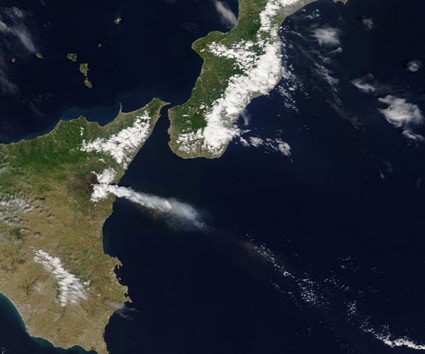
The first eruption of 2016 by Mount Etna, Europe's largest and most active volcano, was both complex and dramatic. The Moderate Resolution Imaging Spectroradiometer (MODIS) aboard NASA's Aqua spacecraft captured this true-color image on May 18 as the volcano sent ash high into the atmosphere. The ash was quickly blown southeastward over the Mediterranean Sea. Aqua was launch from Vandenberg AFB, Calif. in 2002. Image Credit: Jeff Schmaltz, MODIS Land Rapid Response Team, NASA GSFC
(MAY 17) A new NASA study modeling conditions in the ocean of Jupiter's moon Europa suggests that the necessary balance of chemical energy for life could exist there, even if the moon lacks volcanic hydrothermal activity. More
(MAY 11) A SpaceX Dragon cargo spacecraft splashed down in the Pacific Ocean at 2:51 p.m. EDT Wednesday, May 11, about 261 miles southwest of Long Beach, California, with more than 3,700 pounds of NASA cargo, science and technology demonstration samples from the International Space Station.
The Dragon spacecraft will be taken by ship to Long Beach where some cargo will be removed and returned to NASA, and then be prepared for shipment to SpaceX's test facility in McGregor, Texas, for processing.
A variety of technology and biology studies conducted in the unique microgravity environment of the space station returned aboard the commercial resupply spacecraft, including research in the burgeoning field of nanotechnology.
The spacecraft also returned to Earth the final batch of human research samples from former NASA astronaut Scott Kelly's historic one-year mission.
Dragon currently is the only station resupply spacecraft able to return a significant amount of cargo to Earth. The spacecraft lifted off from Cape Canaveral Air Force Station in Florida April 8, and arrived at the space station April 10, carrying almost 7,000 pounds of supplies and scientific cargo on the company's eighth NASA-contracted commercial resupply mission.
NASA
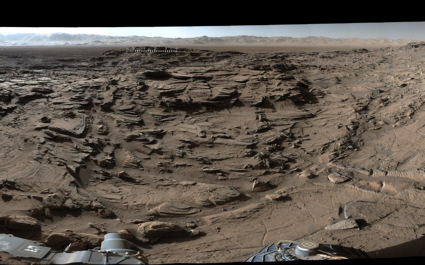
This view from NASA's Curiosity Mars rover released on April 27 shows the rugged surface of "Naukluft Plateau" and part of the rim of Gale Crater. The image was taken as part of long-term campaign to document the context and details of the geology and landforms along Curiosity's traverse since its landing in 2012. NASA's Jet Propulsion Laboratory in Pasadena, Calif. manages the Mars Science Laboratory project for NASA. Image courtesy NASA/JPL-Caltech/MSSS
(APR 24) The Ventura County Astronomical Society will host a family friendly observing session on May 7 at Moorpark College. The event will take place from 9 to 11 p.m. at the college observatory at 7075 Campus Road, Moorpark, Calif.
For more information, go to www.vcas.org.
Ventura County Astronomical Society
(APR 22) BOULDER, Colo. -- Ball Aerospace has begun environmental testing on the U.S. National Oceanic and Atmospheric Administration's (NOAA) Joint Polar Satellite System (JPSS-1) satellite. More
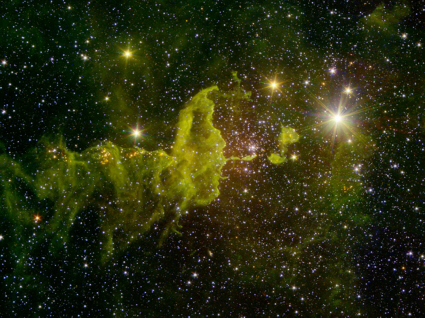
The spider part of "The Spider and the Fly" nebulae, abounds in star formation, in this composite infrared image from NASA's Spitzer Space Telescope and the Two Micron All Sky Survey (2MASS). 2MASS 1.2 micron data is shown in blue. Spitzer 3.6 and 4.5 micron data are green and red, respectively. The Jet Propulsion Laboratory (JPL) in Pasadena, Calif. manages the Spitzer mission for NASA. The California Institute of Technology and JPL are participants in the 2MASS project. Image courtesy of NASA/JPL-Caltech/2MASS
(APR 14) NASA's Cassini spacecraft has detected the faint but distinct signature of dust coming from beyond our solar system. More
(APR 7) CENTENNIAL, Colo. - Applications are now open for U.S. colleges and universities to compete for free CubeSat rides on United Launch Alliance (ULA) Atlas V rockets.
CubeSat competition applications, available at www.ulalaunch.com/cubesats.aspx, are due June 1, 2016, and winning schools will be announced during the summer. The competition is open to all U.S. accredited colleges and universities, which are encouraged to team or perform outreach with K-12 schools to further expand these opportunities throughout the STEM community.
CubeSats are miniaturized satellites originally designed for use in conjunction with university educational projects and are typically 10 cm x 10 cm x 10 cm (4 inches x 4 inches x 4 inches) and approximately 1.3 kg (3 lbs).
Rideshare is a flight-proven, innovative approach that provides customers a low-cost way to achieve various mission objectives without the need for a dedicated launch vehicle.
United Launch Alliance
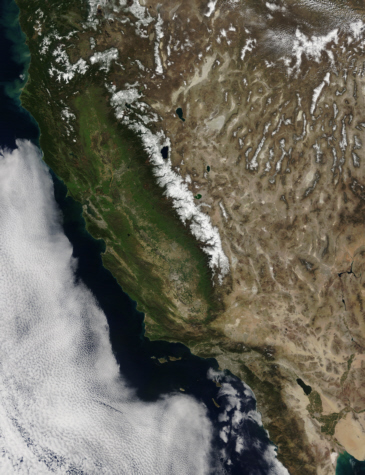
A wealth of detail is visible in California and surrounding areas in this recently-released image from NASA's Terra spacecraft. The Moderate Resolution Imaging Spectroradiometer (MODIS) instrument aboard Terra recorded this true-color image during a daylight pass over the region on March 17. Image Credit: Jeff Schmaltz, MODIS Land Rapid Response Team, NASA GSFC
(MAR 29) NASA has selected a team to build a new, cutting-edge instrument that will detect planets outside our solar system, known as exoplanets, by measuring the miniscule "wobbling" of stars. More
(MAR 23) TUCSON, Ariz. - A new study published Wednesday in Nature reports that the moon may not have always had the same face pointed toward the Earth. More
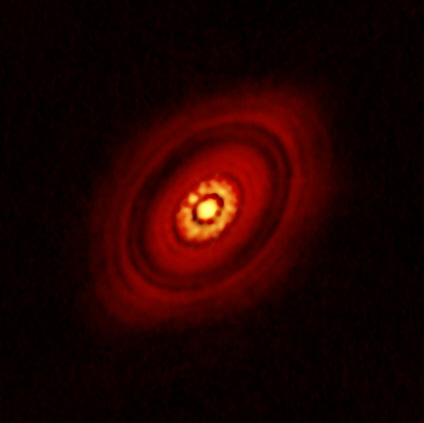
The earliest stages of planet formation are visible in this radio image of the star HL Tau, located some 450 light-years from Earth. Researchers created the view by combining radio observations from the ALMA radio telescope array in Chile and the Very Large Array in New Mexico. ALMA and the VLA observed the star at a wavelength 1 millimeter and 7 millimeters, respectively. The longer wavelength VLA data penetrated the dusty region surrounding the star, revealing a ring with a distinct clump of dust containing roughly 3 to 8 times the mass of the Earth (shown in yellow). The VLA consists of 27 radio antennas west of Socorro, NM. Credit: Carrasco-Gonzalez, et al.; Bill Saxton, NRAO/AUI/NSF.
(MAR 15) SANTA BARBARA, Calif. - Jupiter returns to the night sky for stargazers at this month's free public viewing of the stars with Westmont's powerful Keck Telescope on Friday, March 18, beginning at 7:30 p.m. and lasting several hours at the Westmont Observatory.
"At long last Jupiter will be high in the sky during viewing time," says Tom Whittemore, Westmont physics instructor. "If the seeing is good, we should be able bring out some of the details in the surface structure of Jupiter."
Earlier in the evening, Whittemore will point the college's 8-inch refractor telescope at the 11-day-old moon. "The moon will lie very high in the sky in the early evening," he says. "If the seeing is particularly good, we should be able to make out considerable detail in the large crater, Copernicus. Particularly interesting will be the terracing on the crater's walls as well as the mountain peaks in the middle of Copernicus. These peaks were left behind as the result of a large impact in the early history of the Moon. Some of the ray structure surrounding the crater, Tycho, should also be evident."
Finally, the viewing will include several of the brighter open clusters near the top of the sky, such as Messier 35 in Gemini, and Messiers 36, 37 and 38, a wonderful trio of open clusters in Auriga, the Charioteer.
The observatory opens its doors to the public every third Friday of the month in conjunction with the Santa Barbara Astronomical Unit, whose members bring their own telescopes to Westmont for the public to gaze through. The Keck Telescope is housed in the observatory between Russell Carr Field and the track and field/soccer complex. Free parking is available near the baseball field.
Westmont College
(MAR 10) PASADENA, Calif. - NASA has selected a proposal from the Jet Propulsion Laboratory, Pasadena, California, that will put a new instrument in low-Earth orbit to track harmful particulate air pollutants.
Observations of small atmospheric aerosols from the Multi-Angle Imager for Aerosols (MAIA) will be combined with health information to determine the toxicity of different particulate matter types in airborne pollutants over the world's major cities. David Diner of JPL is the principal investigator.
MAIA uses a twin-camera instrument that will make radiometric and polarimetric measurements needed to characterize the sizes, compositions and quantities of particulate matter in air pollution. As part of the MAIA investigation, researchers will combine MAIA measurements with population health records to better understand the connections between aerosol pollutants and health problems such as adverse birth outcomes, cardiovascular and respiratory diseases and premature deaths.
The MAIA team has extensive experience in polarimetry, air pollution and human health. Diner has led numerous polarimetry observations from sub-orbital platforms throughout his career. The team includes partnerships with NASA's Langley Research Center in Hampton, Virginia, and Goddard Space Flight Center in Greenbelt, Maryland, as well as several universities, federal research organizations and international partners.
Adapted from a Jet Propulsion Laboratory News Release
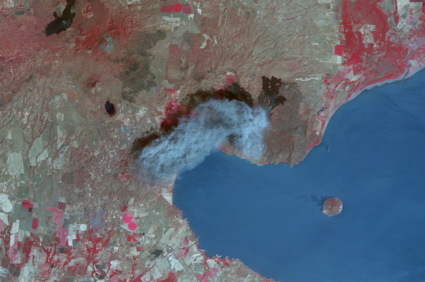
More than 16 years after launch from Vandenberg AFB, Calif., NASA's Terra spacecraft continues to provide a stream of images of planet Earth. On March 2, the craft passed over Nicaragua and returned this false-color image of the plume from the Momotombo volcano, which was erupting for the first time in more than a century. In this view, vegetation appears red, the volcanic plume is blue-gray, and lava flows are dark gray and brown. Image courtesy of NASA
(MAR 3) PASADENA, Calif. - At the Palomar Observatory near San Diego, astronomers are busy tinkering with a high-tech instrument that could discover a variety of objects both far from Earth and closer to home. More
(FEB 26) VANDENBERG AIR FORCE BASE, Calif. - An unarmed Minuteman III intercontinental ballistic missile was launched during an operational test at 11:01 p.m. PST here Thursday, Feb. 25, 2016.
Col. J. Christopher Moss, 30th Space Wing commander, was the launch decision authority.
"This is the second ICBM launch from Vandenberg Air Force Base in the past 5 days and while it may seem routine, a tremendous amount of effort is required to safely assess the current performance and validate the security of the Nation's fielded ICBM force," said Moss. "Our teams are made of dedicated Airmen who make a difference for the Air Force and the nation and I am proud to be a part of this team."
Vandenberg AFB
(FEB 24) VANDENBERG AIR FORCE BASE, Calif. - An operational test launch of an Air Force Global Strike Command unarmed Minuteman III intercontinental ballistic missile is scheduled between 11:00 p.m. PST Thursday, Feb. 25 and 5:00 a.m. PST Friday, Feb. 26, 2016, from north Vandenberg Air Force Base.
The purpose of the ICBM test launch program is to validate and verify the effectiveness, readiness and accuracy of the weapon system, according to Air Force Global Strike Command.
Col. J. Christopher Moss, 30th Space Wing commander, is the launch decision authority.
"The launch process requires tremendous teamwork and involves months of preparation," said Moss. "The data gained from these launches allows us to maintain a high readiness capability and ensures operational effectiveness of the most powerful weapons in the nation's arsenal."
The launch team, under the direction of the 576th Flight Test Squadron, includes crew members and maintainers from the 91st Missile Wing, Minot AFB, North Dakota.
The 576th FLTS is responsible for installed tracking, telemetry and command destruct systems on the missile, which collect data and ensure safety requirements are met.
Vandenberg AFB
(FEB 21) VANDENBERG AIR FORCE BASE, Calif. - A team of Air Force Global Strike Command Airmen from the 91st Missile Wing at Minot Air Force Base, North Dakota, and the 625th Strategic Operations Squadron at Offutt AFB, Nebraska, aboard the Airborne Launch Control System, launched an unarmed Minuteman III intercontinental ballistic missile equipped with a test reentry vehicle at 11:34 p.m. Pacific Standard Time, Feb. 20, from Vandenberg AFB, California. More
(FEB 18) VANDENBERG AIR FORCE BASE, Calif. - - An operational test launch of an Air Force Global Strike Command unarmed Minuteman III intercontinental ballistic missile is scheduled between 11:00 p.m. PST Saturday, Feb. 20 and 5:00 a.m. PST Sunday, Feb. 21, 2016, from north Vandenberg Air Force Base.
The purpose of the ICBM test launch program is to validate and verify the effectiveness, readiness and accuracy of the weapon system, according to Air Force Global Strike Command.
Col. J. Christopher Moss, 30th Space Wing commander, is the launch decision authority.
"This mission continues a long string of vital ICBM flight tests from Vandenberg Air Force Base," said Moss. "The launch not only demonstrates the apability of the Minuteman III weapon system, but also the tremendous capabilities of Airmen who maintain and operate it. The men and women of the 30th Space Wing are proud to partner with the Air Force Global Strike Command team to conduct this important launch."
The launch team, under the direction of the 576th Flight Test Squadron, includes aircrew members from the 625th Strategic Operations Squadron, Offutt AFB, Nebraska, and crew members and maintainers from the 91st Missile Wing, Minot AFB, North Dakota.
The 576th FLTS is responsible for installed tracking, telemetry and command destruct systems on the missile, which collect data and ensure safety requirements, are met.
Vandenberg AFB
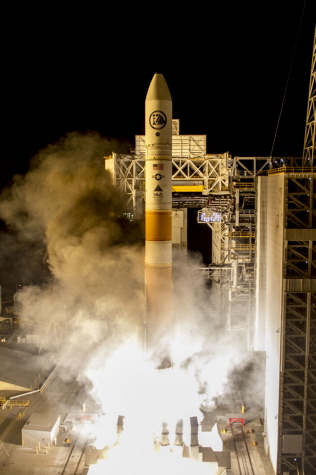
A United Launch Alliance (ULA) Delta IV rocket carrying the NROL-45 mission lifts off from Space Launch Complex 6 at Vandenberg AFB on February 10. Photo courtesy ULA
(FEB 10) Vandenberg Air Force Base, Calif., (Feb. 10, 2016) - A United Launch Alliance (ULA) Delta IV rocket carrying a payload for the National Reconnaissance Office (NRO) lifted off from Space Launch Complex-6 on Feb. 10 at 3:40 a.m. PST. More
(FEB 7) VANDENBERG AIR FORCE BASE, Calif. - Team Vandenberg is scheduled to launch a United Launch Alliance Delta IV rocket carrying a National Reconnaissance Office payload from Space Launch Complex-6 here Wednesday, Feb. 10, with a launch window opening at 3:39 a.m. PDT.
Col. J. Christopher Moss, 30th Space Wing commander, will be the launch decision authority.
"We are excited and ready to take on our first Delta launch of 2016," said Moss. "We are proud to showcase this national capability and everyone involved has been working tirelessly to ensure this launch is a safe and successful one."
Vandenberg's 4th Space Launch Squadron is in final preparations for launch with Vandenberg's mission partners from ULA, the Aerospace Corporation, and the NRO.
"A launch like this takes teamwork and dedication," said Lt. Col. Eric Zarybnisky, 4th SLS commander. "Our mission assurance technicians and engineers have worked hand-in-hand with United Launch Alliance going over critical procedures and tasks to certify this launch is secure."
Vandenberg AFB
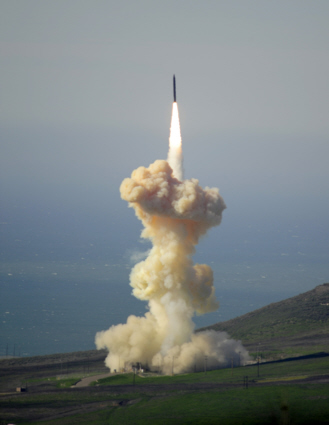
A U.S. Missile Defense Agency flight test of a Ground-based Interceptor launches from Vandenberg Air Force Base, Calif., Jan. 28, at 1:57 p.m. PST. The test was conducted by the 30th Space Wing, MDA, and U.S. Northern Command. U.S. Air Force photo by Staff Sgt. Jim Araos
(JAN 28) VANDENBERG AIR FORCE BASE, Calif. - A Ground-Based Interceptor, an element of the nation's Ground-based Midcourse Defense system, was launched as part of a non-intercept test from North Vandenberg today, Jan. 28, 2016, at 1:57 p.m. PST by the 30th Space Wing, the U.S. Missile Defense Agency, and U.S. Northern Command.
Col. Shane Clark, 30th Space Wing vice commander, was the Launch Decision Authority.
"Both the 30th Space Wing and the Missile Defense Agency worked hard to get the team ready for this test" said Clark. "Today's launch is testament to the professionalism of all involved and the close relationships we have with our missile defense partners."
Vandenberg AFB
(JAN 25) VANDENBERG AIR FORCE BASE, Calif. - A U.S. Missile Defense Agency flight test of a Ground-based Interceptor is scheduled for Thursday, Jan. 28, between the hours of 10:00 a.m. and 2:00 p.m. PST from Vandenberg Air Force Base. The test will be conducted by the 30th Space Wing, the Missile Defense Agency, and U.S. Northern Command.
Col. Shane Clark, 30th Space Wing vice commander, is the Launch Decision Authority.
"The 30th Space Wing has a long and proud history of working diligently alongside our Missile Defense Agency partners to provide safe launch operations for missile defense tests," said Clark. "It's an honor for the wing to work with the Missile Defense Agency and other mission partners on this test mission which is extremely important to our national security."
Vandenberg AFB
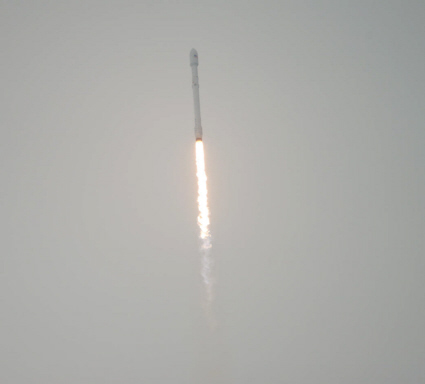
A SpaceX Falcon 9 rocket carrying the Jason-3 spacecraft lifts off from Vandenberg Air Force Base, Calif. on January 17. Image Credit: NASA/Bill Ingalls
(JAN 17) VANDENBERG AIR FORCE BASE, Calif. - Team Vandenberg supported the successful launch of the U.S.-European Jason-3 satellite on a SpaceX Falcon 9 rocket from Space Launch Complex-4 here Sunday, Jan. 17, at 10:42 a.m. PST.
Col. Shane Clark, 30th Space Wing Vice Commander, was the Launch Decision Authority.
"The 30th Space Wing takes pride in supporting the successful launch of the new ocean monitoring satellite with the NASA and SpaceX teams," said Clark. "Today's launch is a testament to the professionalism and commitment to mission assurance, public safety, and mission success on the Western Range."
Jason-3 will continue the ability to monitor and precisely measure global sea surface heights, monitor the intensification of tropical cyclones and support seasonal and coastal forecasts. Jason-3 data will also benefit fisheries management, marine industries and research into human impacts on the world's oceans. The mission is planned to last at least three years, with a goal of five years.
Vandenberg AFB
(JAN 13) A Falcon 9 booster carrying the Jason-3 oceanographic satellite is scheduled for launch from Vandenberg AFB on Sunday morning, January 17. The Falcon is scheduled to lift-off at 10:42:18 PST, the start of a 30-second launch window.
Following liftoff, the Falcon 9 will head towards the southeast and carry Jason-3 into orbit.
Under very good conditions, the bright flame from the Falcon 9's first stage could be visible to the unaided eye as far away as 100 miles. The launch visibility footprint could include Big Sur, Bakersfield, Ventura County, Los Angeles County, and coastal Orange County.
For the best view of the launch, use tripod-mounted or image- stabilized binoculars, a spotting scope, or an astronomical telescope.
Brian Webb
(JAN 7) TUCSON, Ariz. - A student-built experiment designed for the University of Arizona's OSIRIS-REx NASA mission has been integrated onto the spacecraft. More
Copyright © 2017, Brian Webb. All rights reserved.